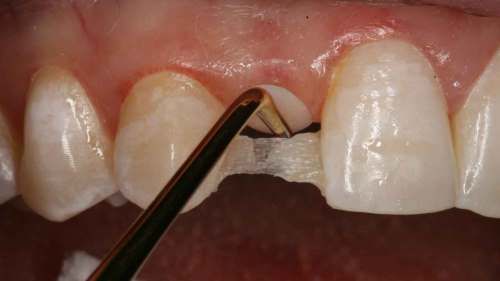Restoring the Peg Lateral Incisor
Dennis Hartlieb
Restoring the Peg Lateral Incisor
I want to share with you today my thoughts and considerations for treating the maxillary peg lateral incisor. While at first glance, the maxillary peg lateral restoration may seem to be pretty straight forward, there are several factors to consider when evaluating these patients for cosmetic dental treatment.
Commonly, other teeth in the maxillary arch are smaller than normal. Research by Jane Wright for her master thesis at Marquette University School of Dentistry, found that the teeth in the maxillary arch can be significantly narrower than average, from 2nd bicuspid to 2nd bicuspid.
Unfortunately, it has been my experience for orthodontists to ignore the issue that many other teeth are narrower than average, and close all spaces, leaving a very large diastema between the canine and the peg lateral. This will most often create a non-restorable clinical situation for the restorative dentists.
Commonly, other teeth in the maxillary arch are smaller than normal. Research by Jane Wright for her master thesis at Marquette University School of Dentistry, found that the teeth in the maxillary arch can be significantly narrower than average, from 2nd bicuspid to 2nd bicuspid.
Unfortunately, it has been my experience for orthodontists to ignore the issue that many other teeth are narrower than average, and close all spaces, leaving a very large diastema between the canine and the peg lateral. This will most often create a non-restorable clinical situation for the restorative dentists.
Therefore, it is absolutely paramount that all teeth in the maxilla be measured to understand if tooth proportions are appropriate in the esthetic zone, and thus determine if there should be ‘sharing’ of spacing with other teeth to minimize the non-restorable oversized diastema.
Orthodontic Positioning of Teeth
Improved Orthodontic Positioning ‘Sharing’
I have also found that it is not uncommon for one or more maxillary teeth to have atypical form in the peg lateral patient. I see this with cuspids especially, but also with the central incisors. It is not unusual that the central incisors are not symmetrical in these peg lateral cases. These aberrant tooth forms will dictate that other teeth, beyond the peg lateral incisors, may need to be treated to create naturally appearing restorations.
Abnormal Tooth Form Right Maxillary Canine.
Finally, and I think a very big issue, I frequently see that there is altered passive eruption, or incomplete gingival tissue migration related to the maxillary dentition, in these peg lateral patients. These patients will often present with short clinical crowns and a gummy smile.
Based on research by Dr. Bill Robbins, we should anticipate that the free gingival margins of the maxillary teeth should be close to the CEJ’s, when the adolescent is around 16 years old.
To differentiate between just a short clinical crown, and to evaluate if there is altered passive eruption, I use an explorer and run the tip under the free gingival margin into the sulcus. I feel for the transition between the smooth enamel surface, and the more ‘pebbly’ feel of the root surface. If, while moving the explorer under the surface, I only feel smooth enamel, likely, the soft tissue has not migrated apically, exposing the full clinical crown of the tooth.
For reference, the average unworn maxillary central incisor is between 10.5-11.5 mm long (based on research by Belser, Magne and others). A normal lateral incisor should be about 9.5 mm, and a canine should measure similar to the maxillary central incisor. In many situations, esthetic crown lengthening is necessary before the cosmetic treatment, to create naturally appearing restorations.
Based on research by Dr. Bill Robbins, we should anticipate that the free gingival margins of the maxillary teeth should be close to the CEJ’s, when the adolescent is around 16 years old.
To differentiate between just a short clinical crown, and to evaluate if there is altered passive eruption, I use an explorer and run the tip under the free gingival margin into the sulcus. I feel for the transition between the smooth enamel surface, and the more ‘pebbly’ feel of the root surface. If, while moving the explorer under the surface, I only feel smooth enamel, likely, the soft tissue has not migrated apically, exposing the full clinical crown of the tooth.
For reference, the average unworn maxillary central incisor is between 10.5-11.5 mm long (based on research by Belser, Magne and others). A normal lateral incisor should be about 9.5 mm, and a canine should measure similar to the maxillary central incisor. In many situations, esthetic crown lengthening is necessary before the cosmetic treatment, to create naturally appearing restorations.
‘Gummy’ smile demonstrating altered passive eruption.
Crown lengthening procedures completed.
Final bonded restorations canine and lateral incisor.
In conclusion, regardless of the restorative material that you will be using to restore the peg lateral incisor, evaluate the other teeth in the arch for tooth size and form to determine if other teeth need cosmetic restorative treatment to create normal tooth form. Additionally, consider if the tissue height is appropriate and if crown lengthening procedures should be recommended before restoring the case.
Yours for better dentistry,
Yours for better dentistry,
Dennis Hartlieb, DDS, AAACD
DOT Founder
Join 3,000+ dentists who get monthly restorative dentistry tips
Share this page
Latest from our blog

Our vision is to provide online continuing education workshops and mentorship that are comprehensive for dentists learning at all career levels. DOT is developed for dentists that love to learn online.
CONNECT
Materials Included
Light Brown tints, Enamelize, Unfilled Resin Flexidiscs, Flexibuffs 1/2", #1 artist’s brush, Silicone Polishing Points, IPC Off Angle Short Titanium Coated Composite Instrument
Materials Needed, not Included
- Loupes
Follow along
You are Registered
We’re excited to have you join us! You’ll receive email reminders at with the link to join this event.
If you have any questions in the meantime, feel free to reach out to us at dot@dothandson.com—we’re here to help!
Day 1 (8 - 4 pm CST)
-
Erosion and wear – the why and the how
-
Adding length to teeth – when is it safe
-
Opening VDO to compensate for lost tooth structure – where to begin
-
Records visit and key points you need to understand before you start
-
The smile – the 7 strategic points to consider when evaluating the smile
-
Anterior tooth shape, morphology
-
Clinical case review
-
Upper Putty matrix construction
-
Build lingual incisal wall with putty matrix #6 - #11/ Upper anteriors
-
Full contour build-up #6, #7, #8, #9, #10, #11, shape and polish/ Upper anteriors
Day 2 (8 - 2 pm CST)
-
Who – which patients are candidates
-
Why – explaining to patients the value of the prototype
-
How – step-by-step techniques to maximize predictability, efficiency and success
-
Getting to Yes: conversations with patients about esthetic and reconstructive dentistry
-
The ‘Smile Preview’ – techniques to show the possibilities
-
Lower Putty matrix construction
-
Build lingual incisal wall with putty matrix #22 - #27 / lower anteriors
-
Build-up #22 - #27, shape and polish / lower anteriors
-
Build-up lower occlusal posteriors
-
Demonstration of Smile Preview
Upcoming Virtual Workshops
Write your awesome label here.
December 11 & 12, 2025
CPR for the Worn Dentition (16 CE)
Write your awesome label here.
January 29-30, 2026
Porcelain Veneer Cementation Workshop (14 CE)
Write your awesome label here.
March 27, 2026
Esthetic and Functional Success for Diastema Closure (8 CE)
Write your awesome label here.
May 15, 2026
From Break to Beautiful: Flawless Class IV Resin Restorations (8 CE)
Write your awesome label here.
June 19, 2026
Mastering Intraoral Scanners and Digital Workflow for the Dental Team (4 CE)
Write your awesome label here.
September 25, 2026
Veneering the Dark Central Incisor - Conservative Direct and Indirect Restorative Strategies (8 CE)
Write your awesome label here.
October 30, 2026
3D Printing for the Restorative Dentist
Write your awesome label here.
December 11, 2026
Injection Molding Workshop (8 CE)
Write your awesome label here.
Study Club
Join five in-depth virtual meetings held on Thursday evenings throughout the year. Engage in detailed case presentations, discuss curated research articles, and exchange valuable tips with fellow dentists.
-
01/22/2026
-
04/09/2026
-
06/11/2026
-
10/15/2026
-
12/10/2026
Write your awesome label here.
Coffee & Donuts
Kickstart your Friday mornings with informal sessions and discuss patient treatments, practice management, and receive feedback on your cases.
-
01/16/2026
-
02/13/2026
-
03/20/2026
-
04/10/2026
-
05/08/2026
-
06/05/2026
-
08/21/2026
-
10/09/2026
-
11/20/2026
-
12/10/2026
Popular On-Demand Courses
Write your awesome label here.
Injection Moulding Techniques (3 CE)
Simple, predictable, systematic foundation for you to start your journey with injection moulding
Write your awesome label here.
Advanced Techniques in Composite Veneers (6 CE)
Take control of aesthetic cases in your practice, whether you are enhancing smiles with direct resin veneers or creating provisional restorations for indirect cases.
Write your awesome label here.
A Realistic Perspective on Occlusal Appliances (3 CE)
Learn how to design, fabricate, and manage occlusal appliances with confidence through practical guidance and real clinical case examples.
Write your awesome label here.
Bicuspid Veneer and V-Onlay Preparation (3 CE)
Gain expertise in ‘prep-less’ veneers, buccal cusp reduction, and margin placement methods to enhance your clinical outcomes.
Write your awesome label here.
Class IV Composite Restoration – Polychromatic Approach (3 CE)
This on-demand course covers material selection and advanced layering techniques to help you create natural-looking, long-lasting restorations that set you apart.
Write your awesome label here.
EXOCAD: Foundation (2 CE)
Gain the skills to confidently navigate Exocad, build patient cases, and streamline your workflow using time-saving techniques and presets.
Write your awesome label here.
Class II Direct Resin (3 CE)
Master a reliable approach to Class II restorations by learning how to create ideal proximal contacts that enhance both the strength and aesthetics of your work.

